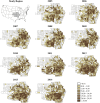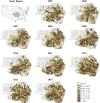Hierarchical Bayesian Spatio-Temporal Analysis of Climatic and Socio-Economic Determinants of Rocky Mountain Spotted Fever
- PMID: 26942604
- PMCID: PMC4778859
- DOI: 10.1371/journal.pone.0150180
Hierarchical Bayesian Spatio-Temporal Analysis of Climatic and Socio-Economic Determinants of Rocky Mountain Spotted Fever
Abstract
This study aims to examine the spatio-temporal dynamics of Rocky Mountain spotted fever (RMSF) prevalence in four contiguous states of Midwestern United States, and to determine the impact of environmental and socio-economic factors associated with this disease. Bayesian hierarchical models were used to quantify space and time only trends and spatio-temporal interaction effect in the case reports submitted to the state health departments in the region. Various socio-economic, environmental and climatic covariates screened a priori in a bivariate procedure were added to a main-effects Bayesian model in progressive steps to evaluate important drivers of RMSF space-time patterns in the region. Our results show a steady increase in RMSF incidence over the study period to newer geographic areas, and the posterior probabilities of county-specific trends indicate clustering of high risk counties in the central and southern parts of the study region. At the spatial scale of a county, the prevalence levels of RMSF is influenced by poverty status, average relative humidity, and average land surface temperature (>35°C) in the region, and the relevance of these factors in the context of climate-change impacts on tick-borne diseases are discussed.
Conflict of interest statement
Figures





References
-
- Burgdorfer W. A Review of Rocky Mountain Spotted Fever (Tick-borne Typhus), its agent, and its tick vectors in the United States. J Med Entomol. 1975;12: 269–278. - PubMed
-
- Dantas–Torres F. Rocky Mountain Spotted Fever. Lancet Infect Dis. 2007;7: 724–732. - PubMed
-
- Centers for Disease Control and Prevention. Rocky Mountain spotted fever (RMSF). Available: http://www.cdc.gov/rmsf/.
-
- Centers for Disease Control and Prevention. Rocky Mountain spotted fever (RMSF). Statistics and epidemiology. Available: http://www.cdc.gov/rmsf/stats/.
-
- Masters EJ, Olson GS, Weiner SJ, Paddock CD. Rocky Mountain spotted fever: A clinician's dilemma. Arch Intern Med. 2003;163: 769–774. - PubMed
Publication types
MeSH terms
Grants and funding
LinkOut - more resources
Full Text Sources
Other Literature Sources

